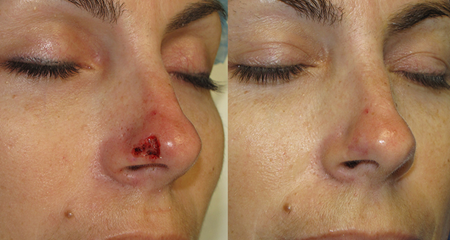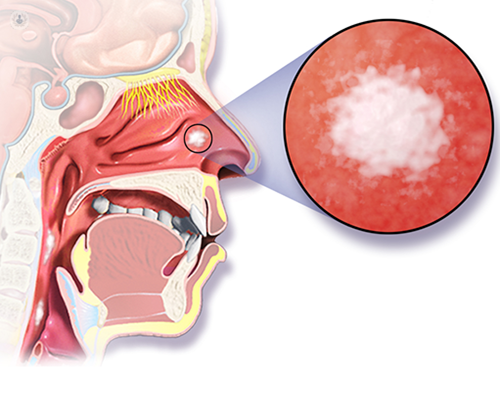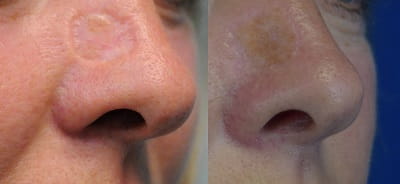Nasal Reconstruction After Cancer in Mumbai
Nasal Reconstruction After Cancer: A Surgical Overview

The nose plays a critical role in both facial aesthetics and breathing. When cancer affects the nasal area, surgery often becomes necessary to remove the diseased tissue. This can leave defects that require reconstruction to restore form and function. Nasal reconstruction after cancer is a complex process, aiming to rebuild the nose’s structure while preserving its appearance and airway.
This topic matters because nasal cancer and its treatment impact patients physically and emotionally. Understanding reconstruction options helps patients make informed decisions. This blog will cover the basics of nasal reconstruction, common causes and concerns related to nasal cancer, treatment approaches, and expert insights to guide those facing this journey.
Understanding Nasal Reconstruction
Nasal reconstruction refers to the surgical process used to repair or rebuild the nose after trauma, disease, or surgery. After cancer removal, defects can range from small skin loss to full-thickness damage involving skin, cartilage, and mucosa. The goal is to restore the nose’s shape, contour, and function.
Key concepts to know:
- Partial-thickness: loss of skin only.
- Full-thickness: involves skin, cartilage, and lining.
- Reconstruction Techniques: Use of local flaps, skin grafts, cartilage grafts, or free tissue transfer to cover and rebuild defects.
- Functional Considerations: Maintaining or restoring nasal airway to ensure proper breathing.
Nasal reconstruction is tailored based on the defect’s size, location, and depth. Surgeons often follow a stepwise plan, reconstructing the internal lining first, followed by cartilage support, and finally the outer skin.
Causes and Common Concerns of Nasal Cancer

Most nasal cancers arise from the skin or mucosal lining of the nose. The primary causes include:
- Basal Cell Carcinoma (BCC): The most common skin cancer, often caused by sun exposure. It grows slowly but can cause extensive local damage.
- Squamous Cell Carcinoma (SCC): More aggressive than BCC and can spread to lymph nodes.
- Melanoma: A rare but serious form of skin cancer involving pigment-producing cells.
Symptoms to watch for:
- Non-healing ulcers or sores on the nose
- Persistent nasal obstruction or bleeding
- Visible lumps or skin changes
Common patient concerns include the fear of disfigurement, loss of nasal function, and uncertainty about surgical outcomes. Psychological impact is significant, as the nose is central to facial identity.
Treatment Approaches and Reconstruction Options

The treatment of nasal cancer typically involves surgical excision with clear margins. Post-excision, reconstruction restores form and function.
Surgical Options:
- Primary Closure and Skin Grafting:
Suitable for small, superficial defects.
Skin grafts replace missing skin but lack structural support. - Local Flaps:
Tissue adjacent to the defect is moved to cover the area.
Examples: Nasolabial flap, forehead flap.
Forehead flap is a workhorse technique for larger defects, providing skin similar in texture and color. - Cartilage Grafting:
Cartilage from the ear or rib restores nasal framework.
Essential for maintaining nasal shape and airway patency. - Free Tissue Transfer:
For extensive defects, tissue from distant sites is transplanted with microvascular connections.
Staged Reconstruction:
Often, reconstruction is done in multiple stages. The first surgery addresses lining and support. Later procedures refine contour and aesthetics.
Other Treatments:
Radiation therapy may be used pre- or post-surgery to control cancer. It can affect healing and reconstruction choices.
Expert Recommendations and Additional Insights
Dr. Vinay Jacob, Senior Plastic and Reconstructive Surgeon, emphasizes personalized treatment plans. His approach involves:
- Detailed assessment of defect size and patient health
- Choosing the least invasive yet effective reconstruction method
- Prioritizing both nasal function and aesthetic outcome
- Planning staged surgeries when needed to optimize results
- Educating patients on realistic expectations and postoperative care
Patients benefit from multidisciplinary care, involving oncologists, radiologists, and rehabilitation specialists. Emotional support and counseling are equally important.
Meet Dr. Vinay Jacob
Dr. Vinay Jacob has over 25 years of experience in plastic and reconstructive surgery. He trained at prestigious institutions like St. John's Medical College and Tata Memorial Hospital. His expertise covers nasal and respiratory procedures, breast reconstruction, and limb salvage, among others.
You can consult him at the Reconstructive Surgery Centre, Bandra (West), Mumbai. The clinic address is 503, Sagar Fortune Building, Above A Kreations, Waterfield Road, Bandra (West), Mumbai - 400050.
FAQs
1. Is nasal reconstruction painful?
Surgeries are performed under anesthesia. Postoperative pain is managed with medications and is generally well-controlled.
2. How long does recovery take?
Initial healing takes 2-3 weeks. Full recovery and final results may take several months, especially if staged surgeries are involved.
3. Will I have scars?
Scarring is inevitable but minimized through careful surgical technique. Over time, scars usually fade and become less noticeable.
4. Can nasal function be fully restored?
The goal is to restore normal breathing. Most patients regain good nasal airflow after reconstruction.
5. Are there risks of complications?
As with any surgery, risks include infection, bleeding, or flap failure. Your surgeon will discuss these in detail.
6. Is radiation therapy compatible with reconstruction?
Radiation can affect healing. Timing reconstruction before or after radiation depends on your case.
7. How to prepare for nasal reconstruction surgery?
Follow preoperative instructions, including stopping smoking, controlling chronic illnesses, and arranging support at home.
8. Can reconstruction be done immediately after cancer removal?
Sometimes immediate reconstruction is possible, but in some cases, delayed reconstruction yields better outcomes.
Conclusion
Nasal reconstruction after cancer removal is a journey that requires surgical skill and patient resilience. Restoring the nose’s appearance and function improves quality of life and confidence. If you or a loved one faces nasal cancer, consulting a qualified reconstructive surgeon like Dr. Vinay Jacob can provide the guidance and treatment needed for the best possible outcome.

